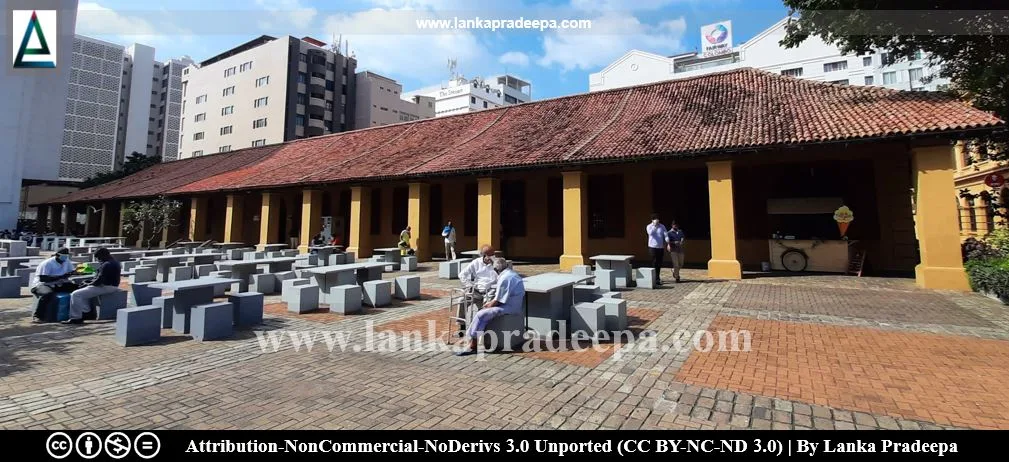
The Old Colombo Dutch Hospital (Sinhala: පැරණි ලන්දේසි රෝහල) is a well-preserved 17th-century Dutch structure situated in Colombo Fort, Sri Lanka. Presently it is used as a shopping complex named "The Dutch Hospital Shopping Precinct" (Manathunga, 2016; Rajapakshe et al., 2018).
History
Some maritime provinces of Sri Lanka were occupied by the Dutch from 1658 to 1796 until they were succeeded by the British who conquered Sri Lanka in 1815 (Uragoda & Paranavitana, 1985).
The exact date when the hospital was built is not known (Silva, 1988). A
note written in 1677 by Christopher Schweitzer, a German soldier
employed by the VOC (Dutch East India Company), records that there were more soldiers in the
Colombo hospital than in the garrison (Silva, 1988). Therefore, it is
assumed that this hospital was already in existence in 1677 (Silva,
1988). A Dutch map drawn in 1732 shows the hospital at the present site
(Uragoda & Paranavitana, 1985).
The hospital is mentioned in
notes by several writers such as Heydt who stayed in Sri Lanka during
1734-1737 and Schweitzer (Silva, 1988). The front and rear views of this hospital are found depicted in two paintings drawn in 1771 by a Dutch painter (Silva, 1988; Uragoda & Paranavitana, 1985). In 1786 the hospital was extended and improved to unable an intake of 300 patients (Manathunga, 2016;
Rajapakshe et al., 2018; Silva, 1988; Uragoda & Paranavitana, 1985).
The
British who succeeded the Dutch in 1796 continued to use the hospital
(Silva, 1988; Uragoda & Paranavitana, 1985). A note in 1803 by
Captain Robert Percival mentions this hospital (Silva, 1988). Later, the building housed the Colombo Apothecaries and then became the office of the Colombo Fort Police Station from the early 1980s to the 1990s (Welandawe & Weerasinghe, 2016).
The building
Two watercolour paintings by a Dutch artist (probably Johannes Rach) in 1771 reveal the front and rear views of this hospital (Silva, 1988; Uragoda & Paranavitana, 1985). As shown by them, the building appears to have not undergone large changes in the past few centuries (Silva, 1988; Uragoda & Paranavitana, 1985). However, it is seen that the original landscaping of the building has disappeared with time (Uragoda & Paranavitana, 1985).
The architecture of the building is simple. It consists of five wings and four of them form a square around a central courtyard (Silva, 1988; Uragoda & Paranavitana, 1985). The fifth wing is situated in front of the square with a facade to the building and a second courtyard intervening (Silva, 1988; Uragoda & Paranavitana, 1985). It also has a narrow upper storey with a wooden floor (Silva, 1988).
As found in the other remaining Dutch buildings, the walls of this building are over 50 cm thick and made of Kabok (laterite) and limestones (Rajapakshe et al., 2018; Uragoda & Paranavitana, 1985). Massive teak beams have been used for the roof (Uragoda & Paranavitana, 1985). A long and wide open verandah runs along the length of each wing (Uragoda & Paranavitana, 1985).
A protected monument
The old Dutch hospital located between the Hospital Road and the Canal Row road in Colombo Fort, in the Divisional Secretary’s Division of Colombo, is an
archaeological protected monument, declared by a government gazette
notification published on 8 July 2005.
 .
.See also
References
1) De Silva, R.R.K., 1988. Illustrations and Views of Dutch Ceylon 1602-1796: A Comprehensive Work of Pictorial Reference with Selected Eye-Witness Accounts. Brill Archive. pp.249-250.
2) Manathunga, S. B., 2016. Pauranika Sthana Saha Smaraka: Kolamba Distrikkaya (In Sinhala). Department of Archaeology (Sri Lanka). ISBN: 955-9159-39-9. pp.18-20.
3) Rajapakshe, S.; Bandara, T. M. C.; Vanninayake, R. M. B. T. A. B. (Editors), 2018. Puravidya Sthana Namavaliya: Kolamba Distrikkaya (In Sinhala). Vol. I. Department of Archaeology (Sri Lanka). ISBN: 978-955-7457-19-2. p.18.
4) The Gazette of the Democratic Socialist Republic of Sri Lanka, no: 1401. 8 July 2005.
5) Uragoda, C.G. and Paranavitana, K.D., 1985. The seventeenth-century Dutch hospital in Colombo. Medical history, 29(2), pp.182-192.
2) Manathunga, S. B., 2016. Pauranika Sthana Saha Smaraka: Kolamba Distrikkaya (In Sinhala). Department of Archaeology (Sri Lanka). ISBN: 955-9159-39-9. pp.18-20.
3) Rajapakshe, S.; Bandara, T. M. C.; Vanninayake, R. M. B. T. A. B. (Editors), 2018. Puravidya Sthana Namavaliya: Kolamba Distrikkaya (In Sinhala). Vol. I. Department of Archaeology (Sri Lanka). ISBN: 978-955-7457-19-2. p.18.
4) The Gazette of the Democratic Socialist Republic of Sri Lanka, no: 1401. 8 July 2005.
5) Uragoda, C.G. and Paranavitana, K.D., 1985. The seventeenth-century Dutch hospital in Colombo. Medical history, 29(2), pp.182-192.
6) Welandawe, H., Weerasinghe, J., 2016. Urban Heritage in the Western Region Megapolis Planning Project. p.11.
Location Map
This page was last updated on 14 July 2022

